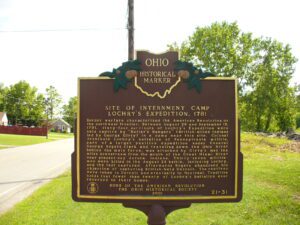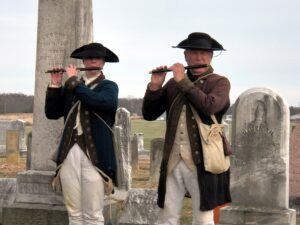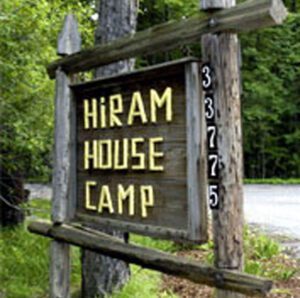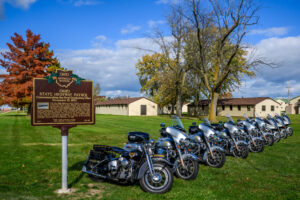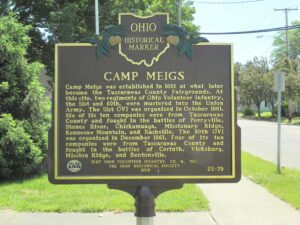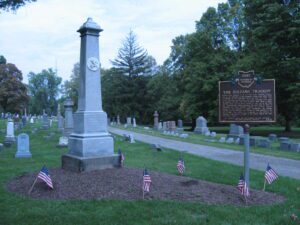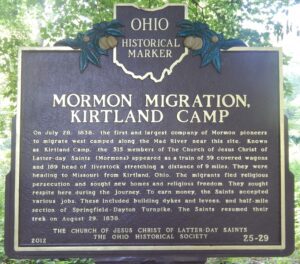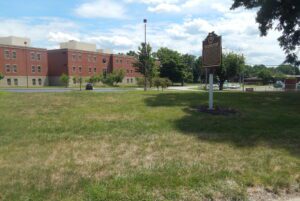, OH
Border warfare characterized the American Revolution on the northwest frontier. Between August 26 and September 15, 1781, sixty-four survivors of Lochry’s Expedition were held captive by “Butler’s Rangers” (British-allied Indians led by George Girty) in a camp near this site. Colonel Archibald Lochry’s battalion of Pennsylvania militia, part of a larger punitive expedition under General George Rogers Clark and traveling down the Ohio River behind the main force, was attacked by Girty’s men ten miles downstream from the mouth of the Great Miami River near present-day Aurora, Indiana. Thirty-seven militiamen were killed in the August 24 battle, including Lochry, and the rest captured. Afterwards Rogers abandoned his objective of capturing British-held Detroit. The captives were taken to Detroit and eventually to Montreal. Tradition holds that fewer than twenty of Lochry’s battalion ever returned to their homes.
, OH
Field Musician Richard W. Thompson. Tunes played on fife and drum regulated a soldier’s life in camp and his actions on the battlefield. Heard over the roar of battle and through the haze of smoke, fifes and drums – field music – communicated orders to massed troops quickly. Richard Willoughby Thompson (c. 1742-1837), buried in Fancher Cemetery, was a field musician during the American Revolution and the War of 1812. According to his grandson Henry’s recollections from the 1920s, Thompson was born in Dublin, Ireland, and enlisted in the British army, where his service culminated in his capture while picking blackberries. He switched allegiances, joined the colonials, and was sent to Virginia. Thompson was appointed the Fife Major of the 5th Virginia Regiment and remained a Fife Major as Virginia units organized during the war. (Continued on other side)
, OH
Hiram House was Ohio’s first settlement house and among the earliest in the nation, opening in October 1896 in Cleveland’s Whiskey Island neighborhood. Representing the ideals of a late-1800s urban progressive movement, settlement houses provided–through “service, not charity” –health, recreational, and self-development opportunities that were not widely available in this era. Founded by Hiram College divinity graduate George A. Bellamy (1872-1960), Hiram House administered a wide range of social services for people of different ethnic and economic backgrounds. Bellamy established the “Fresh Air Camp” circa 1900; Cleveland industrialist Samuel Mather donated this tract of land in 1903. In continuous operation since its founding, Hiram House has provided outdoor experiences and educational programs for thousands of Ohio children.
, OH
This location marks the site where the first Ohio State Highway Patrol cadet class graduated on November 15, 1933. Known as the Camp Perry School, Colonel Lynn Black opened the training on October 3, 1933, after House Bill 270 created the Division. Colonel Black received over 5,000 applications for the inaugural class, which was trimmed to approximately 125 individuals who formed the first training class. The Ohio National Guard graciously volunteered the use of this facility for the training. The newly formed Highway Patrol purchased 54 new motorcycles to be used for patrol duties. Many of the cadets had no prior experience operating motorcycles and had to be trained in short order. Cadets faced extreme adversity, including frigid temperatures and a lack of heating in the facilities. Severe weather shortened training for the cadets. The first class of 60 new Patrolmen graduated on November 15, 1933.
The Ohio State Highway Patrol’s core values are instilled into all new recruits and continually reinforced. They are the foundation upon which a trooper can be a consummate public servant; Adaptability, Attention to Detail, Diversity, Family, Honesty, Officer Safety, Performance Driven, Professionalism, Self-Discipline, Sense of Urgency and Team Oriented.
, OH
Camp Meigs was established in 1861 at what later became the Tuscarawas County Fairgrounds. At this site, two regiments of Ohio Volunteer Infantry, the 51st and 80th, were mustered into the Union Army. The 51st OVI was organized in October 1861. Six of its ten companies were from Tuscarawas County and fought in the battles of Perryville, Stones River, Chickamuaga, Missionary Ridge, Kennesaw Mountain, and Nashville. The 80th OVI was organized in December 1861. Four of its ten companies were from Tuscarawas County and fought in the battles of Corinth, Vicksburg, Mission Ridge, and Bentonville.
, OH
Soldiers from Company F of the 115th Ohio Volunteer Infantry died in the explosion of the steamboat Sultana seven miles north of Memphis on the Mississippi River on April 27, 1865. The Sultana reportedly carried more than 2,400 passengers–six times its capacity of 376. The vast majority were Union soldiers recently freed from Southern prisons at the end of the Civil War. Approximately 1,800 passengers and crew died in what is considered the worst maritime disaster in American history. Company F was organized in Stark, Columbiana, and Portage Counties and was mustered into service at Camp Massillon in the fall of 1862. This marker is a memorial to the soldiers of Company F who died as a result of the Sultana tragedy and other war-related causes.
, OH
On July 28, 1838, the first and largest company of Mormon pioneers to migrate west camped along the Mad River near this site. Known as Kirtland Camp, the 515 members of The Church of Jesus Christ of Latter-day Saints (Mormons) appeared as a train of 59 covered wagons and 189 head of livestock stretching a distance of 9 miles. They were heading to Missouri from Kirtland, Ohio. The migrants fled religious persecution and sought new homes and religious freedom. They sought respite here during the journey. To earn money, the Saints accepted various jobs. These included building dykes and levees, and half-mile section of Springfield-Dayton Turnpike. The Saints resumed their trek on August 29, 1838.
, OH
After the outbreak of the Civil War in the spring of 1861, the U.S. War Department commissioned Ohio Senator B.F. Wade of Jefferson and local Congressman John Hutchins of Warren to supervise the Union Army’s recruiting service in Northeastern Ohio. Recruitment rolls were to be filled in summer so training could be conducted during the fall. The Oak Grove Fairgrounds in Warren, home of the Trumbull County Agricultural Society, was one of the sites selected for the training. This camp was named Camp Hutchins in Congressman Hutchins’ honor. John Hutchins, an attorney by profession, had served as Trumbull County Clerk of Courts and had been assocaited with future Ohio governors David Tod (1862-1864) and Jacob Cox (1866-1868), in their law firms. An ardent anti-slavery man and Underground Railroad agent, Hutchins served in the U.S. Congress from 1859 to 1863.


